Fruit preserves facts for kids
|
Strawberry jam, one type of common fruit preserve
|
|
| Type | Spread |
|---|---|
| Main ingredients | Fruits or vegetables; sugar, honey or pectin |
| 257 kcal (1076 kJ) | |
Fruit preserves are delicious foods made from fruits (and sometimes vegetables!) mixed with sugar. They are often kept in glass jars.
There are many kinds of fruit preserves made all over the world. Some are sweet, like those made from strawberry or apricot. Others can be savory, like those made from tomatoes or squash. The ingredients and how they are prepared decide what type of preserve it is. Jams, jellies, and marmalades are all examples of fruit preserves. In English, the word "preserves" (when plural) is used to describe all these types of jams and jellies.
| Top - 0-9 A B C D E F G H I J K L M N O P Q R S T U V W X Y Z |
What are Fruit Preserves Called?
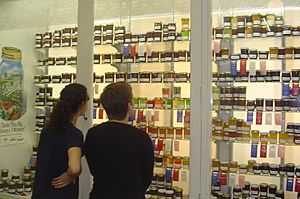
The word preserves is often used to mean the same thing as jams. But there are many other names for these sweet (or sometimes savory) spreads. These include: chutney, confit, conserve, fruit butter, fruit curd, fruit spread, jelly, and marmalade.
Some cookbooks say that preserves are whole fruits (or vegetables) that have been cooked and turned into a gel. They still contain a lot of the fruit pieces. In places where English is spoken, the terms are usually more specific. If not, 'jam' is the most common general word.
Sometimes, the single word preserve or conserve is used for jams that have a very high fruit content. This is often for marketing. Also, the name of the fruit preserve can change depending on where you are in the world.
Different Kinds of Fruit Preserves
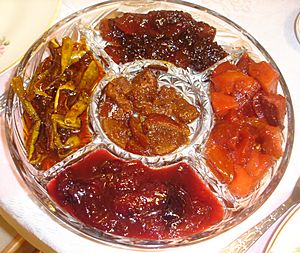
Chutney
A chutney is a type of relish that comes from India. It is made from fruit, spices, and herbs. Chutneys were first meant to be eaten soon after they were made. But today, many chutneys are sold in stores. So, they often have sugar and vinegar added to help them last longer. For example, mango chutney is made by cooking mangoes with sugar until they are thick.
Confit
The word confit comes from a French word meaning "to preserve." While it's often used for preserving meats, it can also describe fruits or vegetables. These are seasoned and cooked with honey or sugar until they become like jam. Savory confits, like those made with garlic, might use olive oil to preserve them.
Konfyt is a type of jam eaten in Southern Africa. It is made by boiling fruits like strawberries, apricots, or oranges with sugar. Sometimes, a little ginger is added for extra flavor. This jam's name comes from the French word confiture.
Conserve
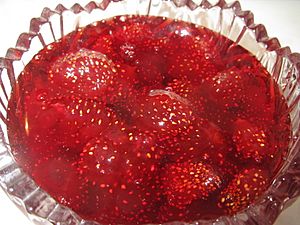
A conserve is also called a whole fruit jam. It is made by stewing fruit in sugar. Traditional whole fruit preserves are very popular in Eastern Europe (like Russia and Ukraine). They are called varenye there. They are also popular in parts of Asia, where they are called murabba.
Making conserves can be a bit tricky. You need to cook the fruit in the hot sugar mixture for just the right amount of time. This lets the flavor come out of the fruit and the sugar get inside it. But you don't want to cook it for too long, or the fruit will break down and become liquid.
Because they are cooked for a shorter time, conserves might be a bit softer than some jams. Another way to make conserves is to layer dry sugar over raw fruit. You leave it for several hours so the sugar soaks into the fruit. Then, you just heat the mixture briefly until it sets.
Some fruits are not good for conserves because their skins are tough and need longer cooking. These include currants, gooseberries, and some plums.
Another way to think of conserves is that they are preserves made from a mix of different fruits or vegetables. Conserves can also include dried fruit or nuts.
Fruit Butter
Fruit butter is made by cooking whole fruit and then pushing it through a sieve or blending it. This makes it very smooth.
Fruit butters are usually made from larger fruits. Examples include apples, plums, peaches, or grapes. The fruit is cooked until soft, then strained to make it smooth. After straining, the pulp is cooked again with sugar. It's cooked quickly with constant stirring. The finished fruit butter should be thick enough to mound up on a spoon, but it won't be as firm as jelly.
Fruit Curd
Fruit curd is a creamy dessert topping and spread. It's often made with lemon, lime, orange, or raspberry. The main ingredients are egg yolks, sugar, fruit juice, and zest (the colored part of the peel). These are gently cooked until thick, then cooled. This creates a soft, smooth, and very flavorful spread. Some recipes also add egg whites or butter.
Fruit Spread
The term Fruit spread doesn't have a strict rule about what it means. Some people think it means a jam or preserve with no sugar added. However, many "fruit spreads" from big companies do have added sugar. You can check the ingredient list on the package to see if sugar is included.
Jam
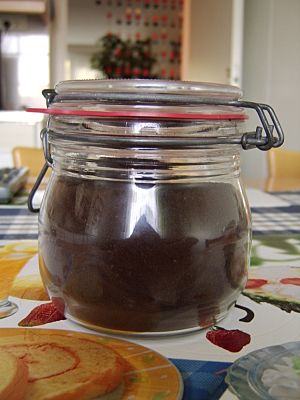
Jam usually contains both the juice and the soft parts of a fruit or vegetable. One cookbook says it's a cooked and gelled puree. Jam is made by cutting or crushing whole fruit. Then, it's heated with water and sugar. This helps the fruit's natural pectin (a substance that helps things set) to work. After cooking, it's put into containers.
Jam is often made from the pulp and juice of one fruit. Berries and other small fruits are commonly used. Larger fruits like apricots or peaches can also be cut into small pieces for jam. Good jam has a soft, even texture without clear pieces of fruit. It has a bright color, a good fruit flavor, and is semi-jellied, so it's easy to spread.
In Canada, jam must have at least 45% of the fruit it's named after. It also needs to have 66% water-soluble solids (which means sugar and other dissolved things). Jam can have small amounts of pectin or acid added if the fruit doesn't have enough natural pectin.
Jelly
In North America, jelly is a clear or see-through fruit spread. It's made from sweetened fruit (or vegetable) juice. This means it doesn't have any fruit flesh, unlike jam. It sets because of the natural pectin in the fruit juice. Outside North America, "jelly" often means a gelatin-based dessert. However, it can also refer to clear jams like blackcurrant or apple jelly.
In the United Kingdom, redcurrant jelly is a sauce often served with meats like lamb or turkey. It's a clear jam that sets with pectin from the fruit. It's made by adding redcurrants to sugar, boiling them, and then straining the mixture.
Marmalade
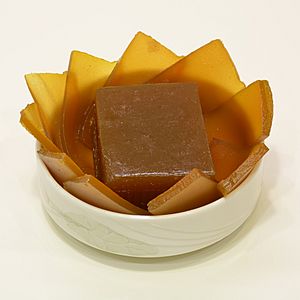
Marmalade is a fruit preserve made from the juice and peel of citrus fruits. These are boiled with sugar and water. You can make marmalade from lemons, limes, grapefruits, oranges, or a mix of these. Marmalade is usually different from jam because it contains pieces of fruit peel.
In Britain, the best citrus fruit for marmalade is the Spanish Seville orange. It's great because it has a lot of pectin, which helps the marmalade set well. The peel of this orange also gives the preserve a special bitter taste. In America, marmalade is usually sweet.
How Fruit Preserves are Made
To make jam, you usually mash or chop fruit (or vegetable pulp). Then, you boil it with sugar and water. The amount of sugar and fruit can change depending on the fruit and how ripe it is. A good starting point is often equal amounts of fruit and sugar.
When the mixture reaches about 104 °C (219 °F), the acid and pectin in the fruit react with the sugar. This makes the jam set when it cools down. Many home cooks don't use a thermometer. Instead, they bring the mixture to a "fast rolling boil" and watch its texture. They might also drop small samples on a plate to see if they set or run.
Big companies make jams using a few methods. One is the open pan method, which is like making jam at home, but on a much larger scale. This method gives the jam a traditional flavor. Another way is using a vacuum vessel. This means the jam is cooked in a vacuum, which lowers its boiling temperature. This helps keep more of the fruit's natural flavors and uses less energy. However, after this, the jam still needs to be heated briefly to about 95 to 100 °C (203 to 212 °F) to kill any tiny germs.
When jars are filled in factories, a flame is often used to sterilize the rim and lid. This kills any yeasts or molds that could spoil the jam. Steam is also often injected before the lid is put on. This creates a vacuum, which helps prevent spoilage and makes the safety button on the lid pop down.
Storing Fruit Preserves
Glass or plastic jars are a great way to store and keep jam fresh. Sugar can last a very long time, and keeping it in a jar is much better than older storage methods. For jams made in factories, they can also be packaged in cans or plastic packets. These are often used in restaurants for single servings. Fruit preserves usually have low water content, so they can be stored at room temperature after opening, as long as you use them fairly quickly.
Images for kids
-
Jars of confiture and gelée for sale in Colmar, France
-
Yuja-cheong (preserved yuja)
-
Homemade English marmalade
See also
 In Spanish: Conservas de frutas para niños
In Spanish: Conservas de frutas para niños








